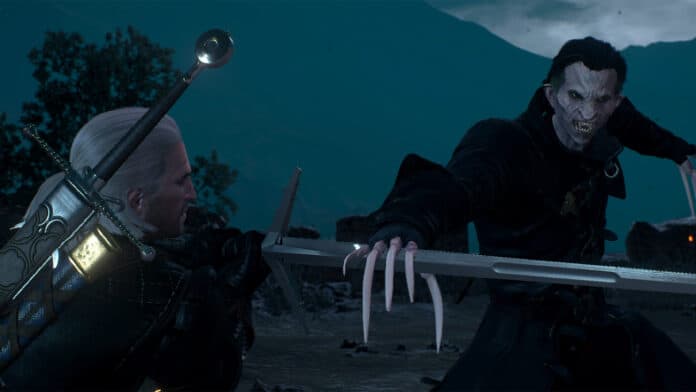The Witcher 3: Wild Hunt is renowned for its complex characters and intricate plotlines, and one of the most compelling narratives is the confrontation between Geralt of Rivia and Dettlaff van der Eretein.
This conflict, central to the game’s Blood and Wine expansion, is not just a battle between two powerful beings but a story rich with themes of morality, choice, and consequence.
This article delves into the depths of the Geralt vs Dettlaff storyline, exploring its nuances and significance within the broader context of the game.
Background: Who is Dettlaff?
Dettlaff van der Eretein, a higher vampire, is a key character in Blood and Wine.
Unlike typical portrayals of vampires, Dettlaff is depicted with depth and complexity. He is introduced as a character with strong moral principles, despite his vampiric nature.
Dettlaff is driven by a personal code, making him a unique and multidimensional antagonist. His background and motivations are crucial to understanding the conflict with Geralt.
Geralt’s Encounter with Dettlaff
Geralt’s initial encounter with Dettlaff sets the stage for their complex relationship.
As a Witcher, Geralt is no stranger to battling monsters, but Dettlaff presents a different challenge. Their interactions evolve from hostility to a mutual understanding, albeit tense, as they navigate the murky waters of Beauclair’s politics and intrigue.
The first time Geralt encounters Dettlaff, known as the Beast of Beauclair, it’s during the Blood Run quest. In this encounter, Dettlaff is in a weakened form, allowing Geralt to get a sense of his attack patterns and weaknesses.
Geralt must use strategies such as applying Vampire Oil to his silver sword for extra damage, utilizing the Black Blood potion to damage Dettlaff when he attacks, and employing defensive magic like Quen and Yrden to protect himself and counterattack effectively
This dynamic is pivotal to the game’s narrative, offering a fresh perspective on the typical hero-villain paradox.
The Conflict’s Motivations
The conflict between Geralt and Dettlaff is rooted in personal motivations and moral dilemmas.
Dettlaff is portrayed not as a mindless monster but as a being with a strong sense of personal justice and morality. His killing spree in Beauclair is primarily motivated by a sense of betrayal and a desire for vengeance.
He is manipulated by Syanna, a key character in the storyline, who deceives him into believing that she loves him. Syanna uses Dettlaff’s feelings for her to make him kill people who have wronged her in the past.
The situation escalates when Syanna betrays Dettlaff, leading him to unleash his fury on the city of Beauclair.
Dettlaff demands that Syanna be brought to him so he can confront her about the betrayal. When his demands are not met, he feels compelled to enforce his own sense of justice, leading to further violence and deaths.
The Showdown: Analysis of the Battle
The final showdown between Geralt and Dettlaff is a culmination of their emotional and ideological conflict.
This battle is not just a test of strength but also a confrontation of their beliefs and choices. The fight is intense and demanding, requiring players to utilize their skills and knowledge of the game’s mechanics to defeat him.
The final confrontation with Dettlaff in “The Witcher 3: Wild Hunt” can be averted based on the player’s in-game decisions. If it does occur, it ranks as one of the most daunting battles in the game.
At the outset, Dettlaff displays similar vulnerabilities and tactics as seen in earlier encounters. This stage serves as an opportunity for Geralt to deal damage and brace for more challenging phases ahead.
Dettlaff undergoes a transformation into a formidable winged creature, employing erratic and powerful attacks. In this more aggressive stage, Dettlaff becomes harder to damage, making strategic and defensive play crucial for Geralt.
Dettlaff’s primary attacks during this phase include a deadly bat swarm, swift aerial dives, and perilous blood spikes that emerge on the ground.
Reducing Dettlaff’s health to one-third triggers a cinematic where Geralt cuts off Dettlaff’s wings, followed by a transition to a bizarre, blood-themed realm.
Here, Geralt’s focus shifts to attacking glowing organs within the arena, vital for weakening Dettlaff. Although this stage is slightly less challenging than the previous, it still poses significant risks and requires strategic combat.
Themes and Symbolism
The Geralt vs Dettlaff storyline is rich in themes and symbolism.
It explores the nature of monstrosity, questioning what it means to be a monster in a world where the line between good and evil is blurred.
The narrative also delves into themes of love, revenge, and the consequences of one’s actions, making the conflict between Geralt and Dettlaff a representation of the game’s broader thematic explorations.
In conclusion
The confrontation between Geralt and Dettlaff in The Witcher 3: Wild Hunt is a narrative masterpiece that goes beyond a simple hero vs villain trope.
It’s a complex tale woven with emotional depth, moral ambiguity, and philosophical questions.
This battle is not just a highlight of the Blood and Wine expansion but a testament to the game’s narrative strength, offering players a profound and thought-provoking experience that resonates long after the game is over.

